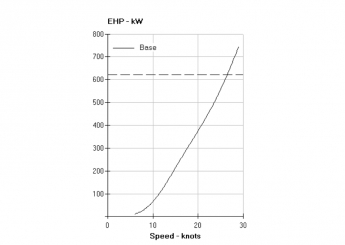CJR can carry out a performance assessment to determine whether a boat’s propulsion system is operating efficiently.
As a first step, we would perform a resistance prediction for the hull. This is based on regression line theory developed by Southampton University on the basis of hundreds of tested hulls and gives an accurate preliminary estimation of hull resistance. Our more sophisticated resistance estimation tool uses Computational Fluid Dynamic (CFD) software that can predict flow around the hull and the hull pressure field as well as running trim angle with great accuracy. It can be further used to find the most optimum LCG position and running trim angle for the boat.
Having calculated the resistance, the theoretical top speed is estimated based on engine power.
The next step is to confirm the gear ratio used in the vessel. Engine power and gear ratio rule all shaftline components scantlings including propellers, shafts, P-brackets and all associated parts. Gear ratio is a factor that has a huge influence on overall propeller performance and should be carefully selected at the design stage.
The optimum propeller design for the given gear ratio is also calculated. CJR uses purpose developed software based on a number of different propeller series for quick selection of diameter, pitch and number of blades. More sophisticated Lifting Line and Lifting Surface software is utilised for detailed blade parameters selection including checking blade area requirement due to cavitation.
Get in Touch
CJR combines decades of experience with continuous investment in the latest technology and engineering prowess. Just drop us a note to find out more about how we can help you.
CONTACT US